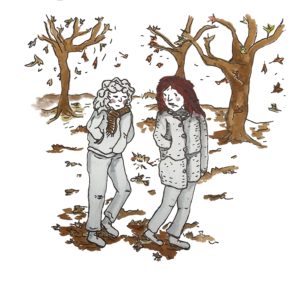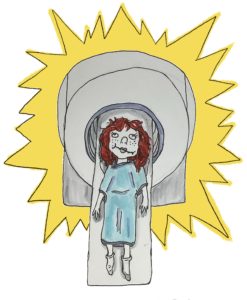INT. CLASSROOM
Fluorescents flicker overhead. There are two small, tinted windows on the wall opposite the door. The carpet is factory-outlet speckled blue. Rows of chairs, each equipped with a dinky desk attachment, line the length of the room.
BROOKE enters classroom. Her mouth is lopsided and her red hair frizzy. She bends over the computer desk to log onto the in-room computer, and “THERE SHE GOES, MY BEAUTIFUL WORLD” by Nick Cave and the Bad Seeds plays on the audio system. Feeling the song, she dances (although her movements are awkward staccatos) as she arranges the desk-chairs into a semi-circle, the locus of a singular point: one desk-chair at the front of the room for herself. It’s obvious from the way she favors the left side of her body that IT DOESN’T WORK PROPERLY; her right arm and leg SHOULDER THE BURDEN of any weight.
BROOKE (VO)
I’m not looking forward to it—quite the opposite, actually—but if it’ll make things easier… or, at least, clearer…
Brooke compulsively pulls the sleeves of her shirt OVER HER KNUCKLES. She will do this repeatedly.
Students file in as the SONG ENDS; Brooke is standing next to the chair she’s placed at the front of the room, waiting. There’s a freewrite projected onto a screen hanging in front of the whiteboard.
ON THE SCREEN
INSERT – FREEWRITE PROMPT, which reads:
Freewrite: What are some advertisements you’ve seen today? Were they before a YouTube video? Posters on the subway? Who were these ads targeting? How does the visual presentation of ads affect their messages?
BACK ON THE CLASSROOM
STUDENTS extract laptops and flip pages in their notebooks. Some give BROOKE peculiar looks; they rarely see her standing.
BROOKE
Before we begin today, I just wanted to clear something up…
Students exchange NERVOUS GLANCES. One stops texting and surreptitiously tucks CELL PHONE in pocket.
BROOKE
Don’t worry—no one’s in trouble or anything. I just wanted to explain why I never write on the board or why I’m stumbling around at 8 a.m.
Students SMILE—is it out of relief, curiosity, or something more sinister? Brooke pulls SLEEVES OVER KNUCKLES. Repeats whenever sleeves shift upward—or even when they don’t.
FLASHBACK – DECIDING TO DISCLOSE
EXT. BOSTON COMMON
BROOKE and MADELINE, another writing instructor with a gorgeous mane and a discerning stare, are walking toward the Park Street T stop. It’s early autumn and the sparseness of foliage and figures in the Common reflects that.
MADELINE
Have they said anything to you about it?
BROOKE
Not directly. But I know they can see me, (MADELINE laughs) and I know how I move! I’m like a drunk gremlin. (BROOKE raises claw-like hands and grasps for invisible items, her hands shake like an infirm witch.) Spasming in slow motion, y’know?
MADELINE
Then just explain to them why. They’re people—you can treat them like people—they’ll understand.
END FLASHBACK
BACK TO THE INT. CLASSROOM
BROOKE
In 2015, I suffered a traumatic brain injury that’s left me permanently disabled. Some side effects of my disability are ataxia and aphasia—
STUDENTS STARE in confusion. The same student as before fishes CELL PHONE out of pocket and LOOKS DOWN. Realizing her rote regurgitation of facts isn’t the most welcoming or warm way to deliver this information, BROOKE changes tactics.
BROOKE
—which are fancy ways of saying I stumble, lose my words, and slur a lot. My fine motor skills aren’t so fine and writing by hand is slow and painful—both for me, physically, and you all, vicariously.
Some students nod with countenances that say, “Sounds about right.” Others pull their mouths into frowns of concern and pity—it isn’t ideal, but BROOKE takes what she can get.
BROOKE
So, uh, you can ask me any questions you’d like, if you’re curious or confused about anything…
STUDENT
(Without raising hand) Were you driving during the car crash—
BROOKE (VO)
It wasn’t a car crash.
SAME STUDENT
—and were you in the hospital? For how long?
BROOKE
It was actually a tree—
Some STUDENTS are aghast, others LAUGH and then immediately STIFLE THAT LAUGHTER; they don’t want to be rude or dismissive. They don’t yet understand laughter is also a reaction to the unexpected, a nervous cover for being unpredictably off-balance. It’s why a key tactic for comedians is misdirection.
You can laugh—it’s ridiculous. (LAUGHS herself.) I fell about twenty-five feet out of a Redwood in Santa Cruz, California. I was in a coma for ten days and inpatient for a month and a half. Then outpatient for about—
BROOKE mentally counts months. As she does so, her witchy fingers pulsate gingerly as if she’s pressing buttons on the world’s most delicate calculator. Sometimes she gets confused and has to rethink facts she thought she had memorized—facts she thought she knew innately.
—four months. (Considers for a moment, PULLS SLEEVES OVER KNUCKLES, and then continues.) I almost majored in math and now I can’t even do simple calculations in my head.
BROOKE’s left leg begins to SHAKE; she’s been standing too long.
DIFFERENT STUDENT
(Matter-of-factly) Well, that doesn’t matter; this is an art school. None of us came here to do math.
Smiling, BROOKE slips into her desk-chair; her leg discontinues its quaking. More students, emboldened by the others, lift hands to ask questions. One student, who had provided BROOKE with an accommodation letter for his own invisible disability at the semester’s start, is among those raising a hand.
STUDENT WITH INVISIBLE DISABILITY
What part of your brain was hurt?
BROOKE
Since it was a closed-head injury…
ANIMATION SEQUENCE – WHAT’S IN HER HEAD?!: CLOSED-HEAD INJURIES AND YOU
CARTOON BROOKE, in the bubbly style of a 1970s educational video, appears on a white background. CARTOON BROOKE has garish red hair and a crooked line for a mouth. Some groovy funk music starts as an MRI machine lowers to make her brain visible inside of her skull. CARTOON BROOKE winks as the real BROOKE continues speaking.
BROOKE (VO)
…it’s classified as diffuse-axonal. That means the brain’s main impact point took the brunt of the damage—for me that was the occipital lobe at the back of the head—
A RED ARROW appears at the back of the cartoon head with a CHIME. It points to the occipital lobe and then disappears.
BROOKE (VO)
—but, because the brain had nowhere to go, it hit the back of the skull and bounced forward.
The BRAIN jostles and flies back, colliding comically with the skull, and then springs forward to bounce against the skull’s front. CARTOON BROOKE goes cross-eyed as the funk music halts.
BROOKE (VO)
It’s kind of like shaking Jell-O in a container.
BACK TO CLASSROOM – ABRUPT CUT FROM ANIMATION
ANOTHER STUDENT
(Scrunches up face in disgust) Gross.
BROOKE
(Nodding) Yeah, it is pretty gross.
BACK TO ANIMATION – WHAT’S IN HER HEAD?!: CLOSED-HEAD INJURIES AND YOU
As the camera zooms out to show CARTOON BROOKE’s full body, the funk music kicks back in. BLUE ARROWS travel from the brain along a route synonymous with the nervous system. The arrows are grooving to the beat and all is well.
BROOKE (VO)
But that, unfortunately, means the vibrations travel through the entirety of the brain, just like the tremors travelling through the Jell-O. Virtually every part of the brain—and by extension, the body—is affected.
Some of the arrows headed toward the left arm and leg TURN RED AND CRASH. Funkadelic’s “MAGGOT BRAIN” displaces the previous feel-good funk, acknowledging the loss of something beautiful. The debilitated arrows’ corresponding appendages twitch, denoted by squiggly lines surrounding the respective body parts, but they otherwise remain still as the CARTOON BODY attempts to take a step. It manages the movement but DRAGS BEHIND the immobile extremities. CARTOON BROOKE frowns and shrugs, but one shoulder refuses to raise as high as the other.
INSERT – ENDING TITLE CARD, which reads (in cursive):
“That’s life!”
BACK TO INT. CLASSROOM – PRESENT
STUDENTS nod in comprehension. All hands are absent from the air, which makes BROOKE feel both relieved and disconcerted. There’s more BROOKE could explain—she’s barely scratched the surface of her deficits—but just like this is a foundational writing course, this is just an introduction to brain damage, invisible disability, physiological trauma. It’s far from comprehensive, just a quick primer to get everyone on the same page, a quick disclosure so BROOKE won’t feel like a fraud, standing—SITTING—before her students, asking them to share themselves while she PULLS HER SLEEVES OVER HER KNUCKLES.
BROOKE
Okay, good talk. Let’s get started on this. (Motions to screen behind her) What ads have you already seen in the few hours of this morning?
MONTAGE – PRIMER AS PROTOCOL
— INT. CLASSROOM – FIRST DAY OF THE SEMESTER — BROOKE, in black and red plaid pants and a clashing blazer, talking to a room full of new students. As she speaks, scene changes to a new classroom with new students and a new color scheme for her fashion nightmare of an outfit.
BROOKE
Upfront, I just want to get this out of the way—
— INT. CLASSROOM – FIRST DAY OF THE SEMESTER — BROOKE, in blue and green plaid pants and a clashing blazer, talking to a room full of new students.
BROOKE
I have brain damage from an accident I was in a few years ago—
— INT. CLASSROOM – FIRST DAY OF THE SEMESTER — BROOKE, in purple and brown plaid pants and a clashing blazer, talking to a room full of new students.
BROOKE
So, if you see me stumbling around or slurring, or notice I rarely write anything by hand—
— INT. CLASSROOM – FIRST DAY OF THE SEMESTER — BROOKE, in teal and pink plaid pants and a clashing blazer, talking to a room full of new students.
BROOKE
That’s why. Feel free to ask me any questions—don’t be embarrassed. After all, we never learn about anything if we don’t ask about what we don’t know.
“SPECIAL PEOPLE” by Betty Davis starts and plays over
INSERT – ENDING TITLE CARD, which reads (in cursive):
“And that’s life!”
***
Rumpus original art by Ciera Dudley.







